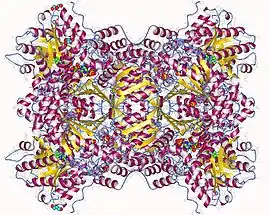Proline dehydrogenase
In enzymology, proline dehydrogenase (PRODH) (EC 1.5.5.2, formerly EC 1.5.99.8) is an enzyme of the oxidoreductase family, active in the oxidation of L-proline to (S)-1-pyrroline-5-carboxylate during proline catabolism. The end product of this reaction is then further oxidized in a (S)-1-pyrroline-5-carboxylate dehydrogenase (P5CDH)-dependent reaction of the proline metabolism, or spent to produce ornithine, a crucial metabolite of ornithine and arginine metabolism. The systematic name of this enzyme class is L-proline:quinone oxidoreductase. Other names in common use include L-proline dehydrogenase, L-proline oxidase,and L-proline:(acceptor) oxidoreductase. It employs one cofactor, FAD, which requires riboflavin (vitamin B2).
| proline dehydrogenase | |||||||||
|---|---|---|---|---|---|---|---|---|---|
 Proline dehydrogenase tetramer, Bradyrhizobium diazoefficiens | |||||||||
| Identifiers | |||||||||
| EC no. | 1.5.5.2 | ||||||||
| CAS no. | 9050-70-8 | ||||||||
| Databases | |||||||||
| IntEnz | IntEnz view | ||||||||
| BRENDA | BRENDA entry | ||||||||
| ExPASy | NiceZyme view | ||||||||
| KEGG | KEGG entry | ||||||||
| MetaCyc | metabolic pathway | ||||||||
| PRIAM | profile | ||||||||
| PDB structures | RCSB PDB PDBe PDBsum | ||||||||
| Gene Ontology | AmiGO / QuickGO | ||||||||
| |||||||||
Proline dehydrogenase is in humans encoded by PRODH[1] and PRODH2[2] genes, located on the chromosomes 22 and 19, respectively. Their mutations lead to hyperprolinemia, manifested by increased proline levels in blood and urine. The deficiency of PRODH has also been linked to the susceptibility to schizophrenia-4.
Structure
The tertiary structure of PRODH consists of two interacting protein chains, connected by a mutual interaction between alpha helices of both chains. Each protein chain binds a separate FAD cofactor, necessary for the oxidative activity of the enzyme. The binding of FAD is mediated by electrostatic and non-polar interactions between the cofactor and twelve amino acid residues.[3] In some bacteria, PRODH activity is exhibited in combination with the activity of (S)-1-pyrroline-5-carboxylate dehydrogenase (P5CDH) in an enzyme encoded by Proline Utilization A (putA) gene.[4] Despite being two separate enzymes, eukaryote PRODH and P5CDH also show substrate channeling capabilities.[5]
Function
PRODH catalyzes the first step of proline catabolism, an FAD-dependent oxidation of proline, summarized by a chemical reaction:
- L-proline + FAD (S)-1-pyrroline-5-carboxylate + FADH2
PRODH is located in the inner mitochondrial membrane, which enables the electrons to be transferred to ubiquinone, a final electron acceptor of the reaction. The activity of this enzyme regulates endogenous proline content, all the while providing reducing power to the electron transport chain, eventually producing ATP.[6]
In plants
PRODH is crucial in regulating intracellular levels of proline, which is an osmotically active compound important in preventing water losses under abiotic stress. Arabidopsis genome contains two PRODH isoforms, PRODH1 and PRODH2, the latter active in response to the osmotic and biotic stress.[7][8] Since the electrons abstracted from L-proline are transferred to electron transport chain, an excessive activity of PRODH may overload the electron transport chain, leading to the generation of reactive oxygen species (ROS), contributing to the hypersensitive response during biotic stress.
Structural studies
As of late 2007, 9 structures have been solved for this class of enzymes, with PDB accession codes 1K87, 1TIW, 1TJ0, 1TJ1, 1TJ2, 1Y56, 2FZM, 2FZN, and 2G37.
References
- "Entrez Gene: PRODH". www.ncbi.nlm.nih.gov. Retrieved 2021-10-05.
- "Entrez Gene: PRODH2". www.ncbi.nlm.nih.gov. Retrieved 2021-10-05.
- White TA, Krishnan N, Becker DF, Tanner JJ (May 2007). "Structure and kinetics of monofunctional proline dehydrogenase from Thermus thermophilus". The Journal of Biological Chemistry. 282 (19): 14316–14327. doi:10.1074/jbc.m700912200. PMC 2708979. PMID 17344208.
- Menzel R, Roth J (September 1981). "Purification of the putA gene product. A bifunctional membrane-bound protein from Salmonella typhimurium responsible for the two-step oxidation of proline to glutamate". The Journal of Biological Chemistry. 256 (18): 9755–9761. doi:10.1016/S0021-9258(19)68828-9. PMID 6270100.
- Sanyal N, Arentson BW, Luo M, Tanner JJ, Becker DF (January 2015). "First evidence for substrate channeling between proline catabolic enzymes: a validation of domain fusion analysis for predicting protein-protein interactions". The Journal of Biological Chemistry. 290 (4): 2225–2234. doi:10.1074/jbc.M114.625483. PMC 4303673. PMID 25492892.
- Servet C, Ghelis T, Richard L, Zilberstein A, Savoure A (January 2012). "Proline dehydrogenase: a key enzyme in controlling cellular homeostasis". Frontiers in Bioscience. 17 (1): 607–620. doi:10.2741/3947. PMID 22201764.
- Rizzi YS, Cecchini NM, Fabro G, Alvarez ME (October 2017). "Differential control and function of Arabidopsis ProDH1 and ProDH2 genes on infection with biotrophic and necrotrophic pathogens". Molecular Plant Pathology. 18 (8): 1164–1174. doi:10.1111/mpp.12470. PMC 6638284. PMID 27526663.
- Funck D, Eckard S, Müller G (April 2010). "Non-redundant functions of two proline dehydrogenase isoforms in Arabidopsis". BMC Plant Biology. 10 (1): 70. doi:10.1186/1471-2229-10-70. PMC 3095344. PMID 20403182.
Further reading
- Scarpulla RC, Soffer RL (September 1978). "Membrane-bound proline dehydrogenase from Escherichia coli. Solubilization, purification, and characterization". The Journal of Biological Chemistry. 253 (17): 5997–6001. doi:10.1016/S0021-9258(17)34569-6. PMID 355248.